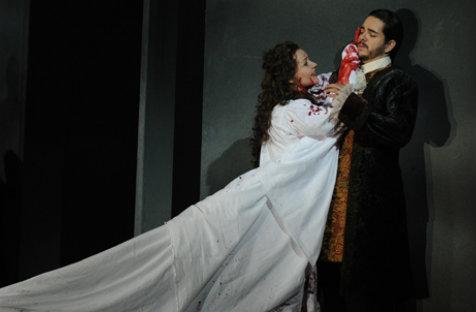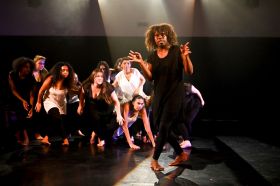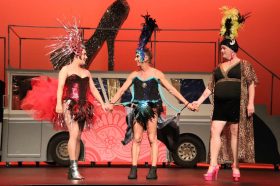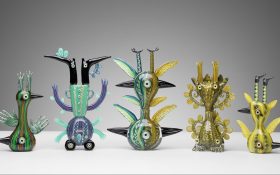If the success of a production of Lucia di Lammermoor stands or falls on the quality of its leading lady, then Opera Australia can stand mighty tall and fiercely proud. A rapturous standing ovation greeted Emma Matthews as she took her curtain calls, validating Opera Australia’s decision to mount this new production.
Above all else, what is required in a bel canto opera is just that: beautiful singing, and Emma Matthews’ voice provides a definition of the term. The role of Lucia is long and demanding, vocally and emotionally. The final mad scene is so long that an audience tends to applaud after the final climactic high note of the first part of the aria, not realising that there are more heights to be scaled. And scale them Emma Matthews did with pure, limpid singing, dazzling coloratura and absolutely secure sustained top notes at full voice.
In addition to her superlative singing, Matthews embodied Lucia’s range of emotions with conviction: fear as she tells the story of a maiden’s ghost that haunts the fountain; ecstatic love for Edgardo, her family’s sworn enemy; horror at Edgardo’s alleged betrayal; and, ultimately, madness as she uncovers the truth and murders her bridegroom, Arturo.
Part of a singer’s power to move an audience lies in the reactions of those surrounding her. Lucia’s brother, Enrico, is very much the villain of the piece. He has slain Edgardo of Ravenswood’s kinsmen and usurped his estates and wishes to repair his now declining fortunes by marrying Lucia off to the prosperous Arturo. Further cynicism is displayed when he assures Arturo that any reluctance on Lucia’s part can be attributed to the recent death of her mother. Given all of that, Enrico’s remorse when Lucia appears in bloodied nightgown and mistakes him for Edgardo can make the tragedy of the scene even more poignant. As Enrico, Giorgio Caoduro intensified the drama most effectively. Caoduro’s angry, ringing tones from earlier in the opera were transmuted into richly voiced sympathy for Lucia’s plight.
Another strength of this production rested in Aldo di Toro as Edgardo. His firm, burnished tenor and his ability to convince as both ardent lover and aggrieved ‘husband’ helped the audience to suspend disbelief when Edgardo finally decides that he has nothing left to live for and stabs himself. After such splendid singing, you could accept anything.
Although Matthews, Caoduro and Di Toro provided the most spectacular vocal highlights, David Parkin as the chaplain Raimondo Teresa la Rocca and Stephen Smith as Arturo made worthy contributions, particularly in the ensembles.
Perhaps more controversial was John Doyle’s new interpretation of Lucia. Lighting and projections by Jane Cox and period costumes by Liz Ascroft were very much an integral part of this minimalist production. As a co-production with Teatro La Fenice and Houston Grand Opera, the mechanics of transplanting the set would certainly be efficient, consisting as it does of panels of painted clouds, which are raised and lowered to depict various spaces. More atmospheric gloom comes in the form of floating mist.
Props are also minimal, consisting of an array of staffs, various chairs, a long table and tablecloth, a large Bible, drinking cups and a large bowl of red wine, which Lucia uses to wash in as she adds to her blood-soaked nightgown. The chorus is dressed in subtle, but unrelenting dark tones, even in the wedding scene. The only tartan that was to be seen was worn by members of the audience, but a brief Highland Fling could be discerned in the dancing of the wedding guests. Although most of the cast was dressed rather dourly, the costumes worn by Emma Matthews were beautiful. Her white satin wedding dress was in striking contrast to the sober background and she has to be given full marks for handling the long train with such skill.
The stylised actions of a chorus in fine voice worked well most of the time, but walking in time (or not quite managing) was a risk perhaps not worth taking and ended up being an unfortunate distraction. If you were wondering whether this is one of those dreary productions where you can hardly see a thing, rest assured that this is not the case. John Doyle places most of the central action at the front of the stage and ensures that it is properly illuminated.
Even those who found the gloom and minimalism not to their taste would have to admit that it did provide for a sharper focus on the music. The beautiful singing was underpinned by some beautiful playing from Orchestra Victoria. Guillaume Tourniaire shaped the orchestra into a sympathetic response to the needs of the style. The very beginning of the opera was heralded by some wonderfully atmospheric soft horns and heart pulsing drum beats. Lucia’s disintegration was accompanied by an instrument designed to resemble a glass harmonica, a sound traditionally associated with madness at the time; the ethereal effect was truly memorable – just like Emma Matthews’ performance. It is not to be missed.
Rating: 4 stars out of 5
Lucia di Lammermoor
Opera Australia
Conductor: Guillaume Tourniaire
Director: John Doyle
Set & Costume Designer: Liz Ascroft
Lighting Designer: Jane Cox
Cast: Emma Matthews, Aldo Di Toro, Giorgio Caoduro, David Parkin, Stephen Smith, Teresa La Rocca and Jonathan Abernethy
Orchestra Victoria
Opera Australia Chorus
Arts Centre Melbourne
19 November – 15 December





